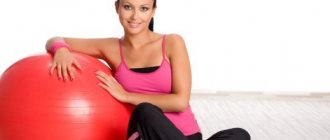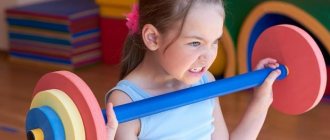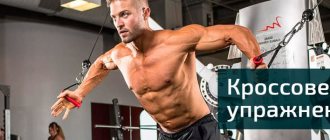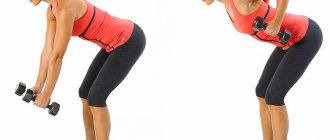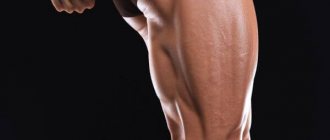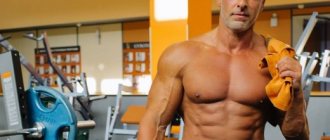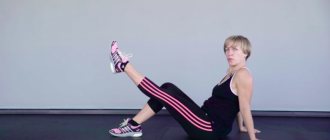Some parents consider exercise unnecessary (“why, there’s physical education at school!”), others don’t have an extra 15-20 minutes for their children, “because it’s work!”
And only a few mothers and fathers understand the importance of exercise for the child, and specifically get up half an hour early in the morning in order to have time to cheer up the child together and prepare the body for the school/work day with the help of effective exercises for children. If your children sleep in class and are constantly shirking physical education lessons, this instruction is for you!
When is the best time for a younger student to do exercises? How to prepare for gymnastics?
Man by nature must move a lot. It’s not for nothing that they say that movement is life. The less a child moves, spending all his free time near the TV and sitting at the computer, the more health problems he gets.
Children's specialists are sounding the alarm and reminding parents that children's bodies should be actively moving at least 10 hours a week, and for younger schoolchildren this minimum increases to 3 hours a day. Moreover, it is desirable that this happens in the fresh air.
Naturally, parents have too little time, but still dedicating 20 minutes in the morning and 20 minutes in the evening for exercise is not that difficult.
What it is
Sports aerobics is rhythmic gymnastics with artistic elements of dance, performed to music. The set of exercises is based on catching the tempo and performing the corresponding task.
This type of training:
- strengthen joints and bone apparatus;
- develop reaction and sense of rhythm;
- increase endurance;
- reduce the risk of spinal problems.
A well-chosen system of exercises allows you to rationally distribute the load on the body, due to which muscle mass is gradually strengthened.
In addition to strength indicators, there is a positive adjustment in flexibility and development of coordination.
How to prepare a child for exercise?
Of course, it’s difficult to get a child out of bed ahead of time, especially “for some kind of exercise.” This wonderful habit must be instilled gradually.
As you know, for a habit to become established, it takes about 15-30 days of regularly repeated actions. That is, after 2-3 weeks of such activities, your child will already be drawn to them.
Without attitude - nowhere. Therefore, the most important thing in forming this habit is to tune in and find motivation.
In addition, it is important that the child’s exercises change periodically (children at this age get tired of the same type of training too quickly).
And don’t forget to praise your child and encourage any physical activity in every possible way.
Competitions
Competitions in types are held with differences in the variety of movements and special devices.
Contestants are selected from the group to perform in pairs, solo, trio, or in the company of six people. To rhythmic music, children demonstrate choreographic, artistic or basic elements lasting 1 minute 45 seconds or a little longer.
Competitions are held between same-sex or mixed teams.
So, here are 15 exercises for younger students:
The first 5 exercises are to warm up the muscles. It is strictly forbidden to do complex exercises immediately after sleep.
- We take a deep breath and rise on our toes. We pull the handles up as high as possible, as if we are trying to reach the ceiling. We lower ourselves to the full foot and exhale. Number of approaches – 10.
- We tilt our head to the left, return to the starting position for a couple of seconds and then tilt our head to the right. Next, we make circular movements with our heads - to the right side, then to the left. Execution time – 2 minutes.
- Now shoulders and arms. We alternately raise one shoulder, then the other, then both at once. Next, we swing our hands upward - in turn, now with our left hand, now with our right hand. Then make circular movements with your arms, as when swimming – first breaststroke, then crawl. We try to do the exercises as slowly as possible.
- We rest our hands on our sides and bend – left, right, then forward and backward. 5 times - in each direction.
- We walk in place for 2-3 minutes, raising our knees as high as possible. Next, we jump 5 times on the left leg, then 5 times on the right leg, then 5 times on both, and then jump with a 180-degree turn.
- We stretch our arms forward, interlock our fingers and stretch forward – as far as possible. Then, without losing the lock, we lower our hands down and try to reach the floor with our palms. Well, we finish the exercise by trying to reach the ceiling with our clasped palms.
- We do squats. Conditions: keep your back straight, legs shoulder-width apart, hands can be clasped behind your head or extended forward. The number of repetitions is 10-15.
- We do push-ups. Boys, of course, do push-ups from the floor, but for girls the task can be simplified - you can do push-ups from a chair or sofa. The number to repeat is from 3-5.
- Boat. We lie down on our tummy, stretch our arms forward and slightly up (lift up the bow of the boat), and also put our legs together, lifting up the “stern of the boat.” We bend the back as hard as possible. Execution time – 2-3 minutes.
- Bridge. We lie down on the floor (children who know how to lower themselves onto the bridge from a standing position, lower themselves straight from it), rest their feet and palms on the floor and, straightening their arms and legs, bend their back in an arc. Execution time – 2-3 minutes.
- We sit on the floor and spread our legs to the sides. We alternately reach out with our hands to the toes of our left foot, then to the toes of our right. It is important to touch your stomach with your leg so that your body lies with your leg - parallel to the floor.
- Bend your left leg at the knee and lift it up, clapping your hands under it. Then repeat with the right leg. Next, we raise the extended left leg as high as possible (at least 90 degrees relative to the floor) and clap our hands under it again. Repeat for the right leg.
- Martin. We spread our arms to the sides, move our left leg back and, slightly tilting our body forward, freeze in the swallow pose for 1-2 minutes. It is important that the body at this moment is parallel to the floor. Next, we repeat the exercise, changing the leg.
- We hold a regular ball between our knees, straighten our shoulders, and rest our hands on our waist. Now we slowly squat, keeping our back straight and the ball between our knees. The number of repetitions is 10-12.
- We rest our hands on the floor and “hover” above it in a “push-up” position. Now slowly, using our hands, we “go” to a vertical position. We rest a little in the “ostrich” pose and “stomp” our hands forward to the original position. We walk back and forth with our hands 10-12 times.
We finish the exercise with a simple exercise for relaxation: we stretch “at attention” while inhaling, tensing all the muscles – for 5-10 seconds. Then we sharply relax at the command “at ease”, exhaling. We repeat the exercise 3 times.
Workout
In certain areas of this sport, classes differ - each type tries to focus on achieving a specific goal.
Fitness
The formation of groups allows the number of participants from 10-15 people. The approach to training is selected according to difficulty levels and presentation. The little ones perform basic components with a coach in a playful way, while the older ones practice logic and learn to work in a team. It is easier to achieve understanding and interest the guys in this way.
The workout is divided into three stages - warm-up, main part and cool-down. The program includes the use of sports equipment purchased independently or purchased by parents if necessary.
Dancing
Dance sections are distinguished by the inclusion of choreographic combinations. They also consist of three parts, but the main one is aimed at learning and remembering a new picture and movements. Suitable for preschool and older ages. Does not require special equipment - only a suit and individual items of clothing.
Step
This type of training is based on interaction with a step board. The complex of classes includes training in jumping and walking on the platform. The intensity depends on the musical accompaniment - the faster the rhythm, the more effective the elements. Equipment is provided by the gym.
Classic
Focused on the basic gymnastics complex. Consists of three parts using specific devices. The musical accompaniment has a medium rhythm so that trainees concentrate on the quality of the exercises.
Where to look for this motivation, and how to entice a child to exercise so that the child enjoys it?
- The main rule is to do exercises all together! Well, if dad categorically refuses, then mom should definitely participate in this process.
- We turn on upbeat and cheerful music. Doing exercises in silence is boring even for an adult. Let the child choose the music!
- We are looking for an incentive in each specific case. For example, an incentive for a girl can be a beautiful, toned figure that everyone will envy, and an incentive for a boy can be muscle definition that he can be proud of. Losing weight if the child is overweight will be no less of an incentive.
- We are looking for those we can imitate. We do not create idols (!), but look for a role model. Naturally, we are looking for him not among bloggers and bloggers with beautiful bodies and emptiness in their heads, but among athletes or heroes of films/movies that the child loves.
- Exercise is needed to become stronger. And you need to be strong (strong) to protect your younger brother (sister).
- In addition to 5 exercises to warm up the muscles, you need to choose another 5-7 exercises for direct exercise. No more is needed for this age, and the workout itself should take no more than 20 minutes (twice a day). But it is important to regularly change the set of exercises so that the child does not get bored! Therefore, immediately make a large list of exercises, from which you will pull out 5-7 new ones every 2-3 days.
- We talk with the child more often about health : why exercise is so important, what it gives, what happens to the body without physical activity, and so on. We are looking for thematic films and cartoons, which we watch, of course, with the child. We often watch films in which young athletes achieve success - often these films become powerful motivators for a child to enter the world of sports.
- Set up a sports corner for your child in his room . Let him have personal parallel bars and rings, a Swedish barre, a fitball, a horizontal bar, children's dumbbells and other equipment. As a reward for each month of training, make it a trip to a trampoline center, play climbing, or another sports attraction. The best home sports complexes for children
- Use his own preferences to attract your child to exercise . For example, if a child loves a ball, consider a set of exercises with the ball. He loves parallel bars - do exercises on the children's playground. Etc.
Rules for working with children
Carrying out a set of physical exercises for children of different ages differs significantly from similar activities with an adult.
There are certain requirements for organizing the training process:
- It is important to teach your child to exercise regularly. This approach allows children to develop a desire for discipline, order, and organization in everyday life.
- It is better to give preference to group classes. If you plan to perform the complex at home, parents should practice together with their children.
- Any power loads should be excluded, especially for the initial stage of training. Exercises with dumbbells and other loading accessories are introduced gradually, in the form of dosed tasks.
- For children of different age groups, the duration of one lesson differs (from 15 minutes for a preschooler to 1.5 hours for a teenager).
- During each session, it is necessary to take into account the state of health and responses to training. Any changes or deterioration in general condition should serve as a signal to stop exercising.
Physical activity should be reduced during certain age periods, for example, at the age of 14-16 years.
It is during this period that uneven growth of the tissues of the heart and surrounding organs is observed. This feature is called “juvenile heart”, and can lead to arrhythmia or spasm of the coronary arteries with inadequate exercise.
Video: Fun exercises for a child
Remember that it is impossible to force a child to exercise like hard labor. It is important that he himself wants to work with you. Therefore, first of all, we demonstrate the importance of charging with our own example.
Children at this age are already excellent at thinking and analyzing, and if you are constantly lying on the sofa, growing a belly, then you simply will not be able to force your child to study - personal example is more effective than all other methods.
The site Colady.ru thanks you for your attention to the article - we hope that it was useful to you. Please share your feedback and tips with our readers!
Kinds
When choosing a suitable direction, it is worth understanding what type of gymnastics is suitable and what it relies on.
There are several varieties suitable for children:
- dance;
- step aerobics;
- fitness;
- classical.
Dance
Dance aerobics for children contains branches with a set of original movements and connections. Hip-hop, salsa aerobics and retro disco are common. Improves the sense of rhythm and flexibility of the body.
Step
Step aerobics for children differs from adults only in the size of the platform and the rhythm of the music. The device is adapted for children: 8 cm in height and 40 cm in length. The exercises consist of repetitive stand-ups with additional tasks included. Trains endurance and breathing apparatus.
Fitness
Combines elements of adult fitness aimed at children, components of physical therapy and educational games. Fitness aerobics for children is useful in strengthening the body and developing flexibility.
Classic
The classical direction does not require special equipment and is performed to music. Strengthens muscles and forms correct posture.
Aqua gymnastics
Children are very accepting of this relatively new method of physical development. You can start exercises at home, in the bathroom and make them the final stage after massage and gymnastics or a separate lesson.
Swimming from the first months of a child’s life is very useful not only for physical development, but also for strengthening the nervous system. The baby is immersed in an environment to which he is accustomed, and this gives him a feeling of psychological comfort. Exercises in water do not overload the child and are especially recommended for children with psychomotor development disorders or diseases of the musculoskeletal and nervous systems.
Swimming:
- strengthens the immune system;
- normalizes sleep;
- regulates metabolism;
- stimulates the gastrointestinal tract;
- saturates the blood with oxygen;
- trains the cardiovascular system;
- forms correct breathing;
- affects the nervous system.
The main thing in classes is their gradualness and systematicity. While the baby gets used to the procedure, you can be in the bathroom with him; usually both the adult and the baby get great pleasure from this.
On the development of sports in Russia
Matveeva Lyubov Karlovna - Chairman of the Sports Aerobics Federation of the Novosibirsk Region, coach of the Russian national team, head coach of the Novosibirsk Region sports aerobics team.
— As a result, what results did your training allow you to achieve this year? And what are your goals for the near future? — All our plans will depend on training events in January. All the leading athletes in Russia come there and the head coach conducts selections and forms team compositions. These are groups where there are dance gymnastics, a gymnastic platform - where there are six to eight people. We are looking at the guys who can show results. Our fate now depends on the head coach. Now there will be a number of preparatory events and minor starts before the Russian Championship. Because in addition to the head coach’s decision, it is important to take first place at the Russian Championship, which gives a ticket to the national team to participate in the World Championship. In sports aerobics it is necessary to constantly change the image in order to be unexpected. For the new season, we need to change something radically, not stand still. Then the judges start paying attention to you: “oh yes, this is something new, this is interesting.” But the most important thing is the elements, gymnastics. Execution is key. In 2022 the rules will change, where performance will be much more important than artistry. Source: Novosibirsk news nsknews.info
Ensuring the safety of children during gymnastics and outdoor games
Fitness is an active group activity, and since children are often inattentive and awkward, injuries can occur.
The number of students in the group should be such that the teacher can easily see and monitor everyone. Training programs take into account the need for less intense exercises, which give the muscles a little rest. The instructor must monitor the children’s backs and breathing, adjust the load and pace, and monitor the safety of performing dynamic exercises.
Now it is necessary to strictly adhere to one more precaution. The years 2020-2021 are passing against the backdrop of a pandemic, and although children are less likely to become infected with coronavirus, the disease is dangerous for both them and their families. If during fitness classes the teacher sees signs of illness in a child, the lesson must be interrupted and the parents of all children notified.
Introduce your child to fitness, look for the direction that interests him most, and he will begin to exercise with pleasure, improving his health.
Basic principles of ball gymnastics
- Strengthening the back muscles - place the child on his stomach.
- Strengthening the abdominal muscles - place the child on his back.
- Strengthening muscles during an umbilical hernia - we place the child on his back.
- General relaxation of the child - usually on the stomach.
- Correction of muscles in case of asymmetry of muscle tone - tilting the ball in the direction where increased tone is observed.
The optimal diameter of the ball for practicing with an infant is 60–65 cm. In infants, in order to reduce increased tone, the ball is lowered slightly; in order, on the contrary, to tone the body, they inflate it tightly. Apart from those common to all types of gymnastics, there are practically no specific contraindications for exercising on a ball, with the exception of an unhealed umbilical wound. You can start classes as early as one month of age.
Don’t worry if at first both you and your baby feel a little unsure and tense: you both will quickly get used to it if you practice regularly and without forcing things.
You will be surprised how quickly your baby’s body will react to such activities: the results of exercises on the ball will be noticeable almost immediately. The baby will become more active, stronger, will no longer be afraid of changes in the position of his body, his sleep and appetite will improve, and he will receive a positive emotional charge.
Basic principles of aqua gymnastics
- Comfortable water temperature in the first lessons is 37 - 37.5 degrees, with a decrease in it by 3 degrees until the end of the first month of swimming, and another 2 degrees in the third. For those who are bolder: please remember that the temperature should not fall below 28 degrees - in this case we are talking about hardening.
- The air temperature in the bathroom is 20 - 22 degrees, the door is open. Classes are held 40–60 minutes after feeding and 30 minutes before it.
- Duration of classes - 5 - 20 minutes.
- Water should be without additives (potassium permanganate, essential oils, herbal decoctions, salt), since baths with these additives are therapeutic and are designed for a lying baby, and aqua gymnastics is a set of active exercises with a fairly intense load on the muscles, respiratory, and cardiovascular systems.
- During exercises in water, the baby's ears may become submerged in water; after exercise, do not forget to dry them.
- The duration of classes in water for babies under 4 months in addition to a general massage is about 5 minutes, for older children - up to 10 minutes.
- As an independent type of exercise, aqua gymnastics is carried out for 15 – 20 minutes.
- Contraindications are: open umbilical wound, skin diseases, poor health and mood of the child, acute respiratory viral and other infections in the active phase (exacerbations), acute period of encephalopathy, rapid increase in intracranial hypertension, convulsions, extreme prematurity of children (rapid cooling) and general contraindications related to the purpose of gymnastics and massage.
Programs by age
When it comes to fitness, age is often a key factor when choosing a type of workout. But if a teacher sees that a student, due to individual character traits, cannot cope or, on the contrary, needs more workload, this must certainly be taken into account.
For children 3-6 years old
The most useful fitness areas for this age group are logarithmics, St. John's exercises, and musical gymnastics. Keep in mind that kids get tired quickly, their ability to coordinate is still very low, so you need to patiently explain tasks, don’t get angry at mistakes, and correct until the exercise is performed correctly.
Another possible area of fitness for children aged 3 years and a little older is fitball. It helps to develop correct posture and strengthen all muscles. Usually kids really enjoy playing with this big ball. The teacher must insure the child and ensure that the spine and neck do not twist or bend excessively. The initial load is minimal with a very slow build-up.
For schoolchildren and teenagers
School-age children will be interested in fitness if they themselves understand the benefits of these activities. For girls it can be a more flexible and developed body, for boys it can be the appearance of sculpted muscles. Dance fitness is very popular among this group, thanks to which teenagers learn to feel better about their body and gain self-confidence. Classes can reveal creative abilities: hearing, voice, increased plasticity, rhythm. It is more correct to introduce children aged 6-14 years to fitness through interest in the future result. How to show it is the parent’s task.
What to buy
This sport does not require large expenses for the purchase of equipment - the necessary things are provided by the gym. The first thing a parent should buy is a tracksuit. Next, the trainer will suggest a list of necessary equipment and things based on the selected type of section.
In fitness, the main featured part of the exercise is the mat. This is the only thing you need to buy for your baby. The rest will be provided by the gym.
In step, as in fitness, there is one main part - the platform. Here it is better to consult with a trainer: if it is not provided, then you must buy it yourself.
Children's aerobics is a contribution to health and rationally spent energy. While training, a novice athlete will discover a new hobby and continue training for the benefit of his own development.
